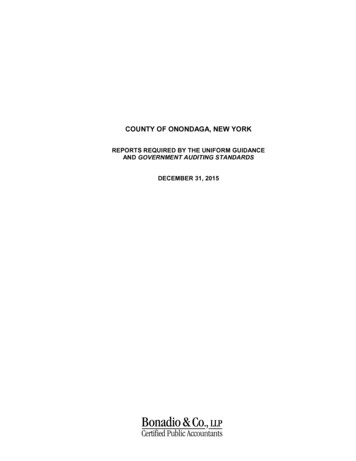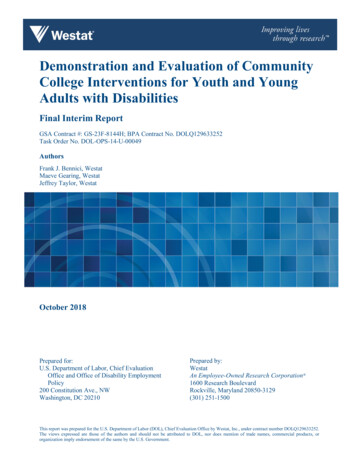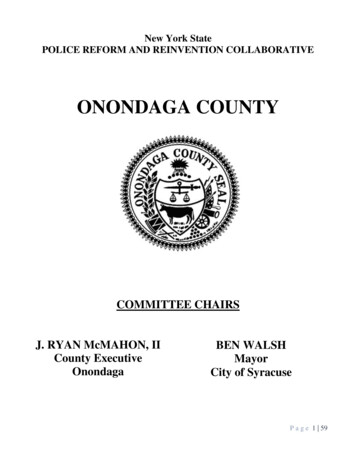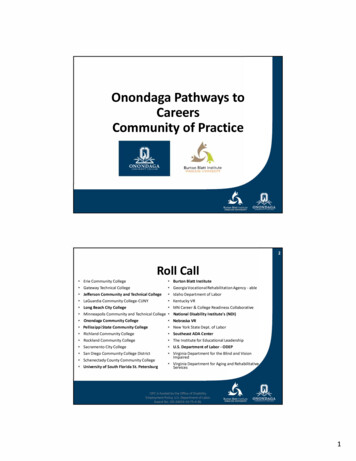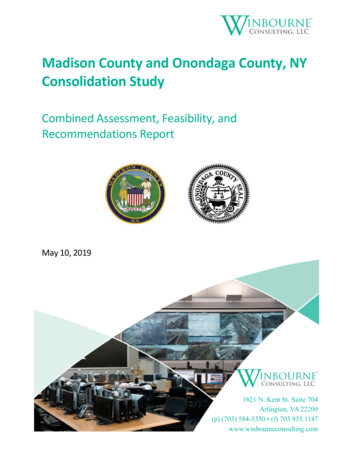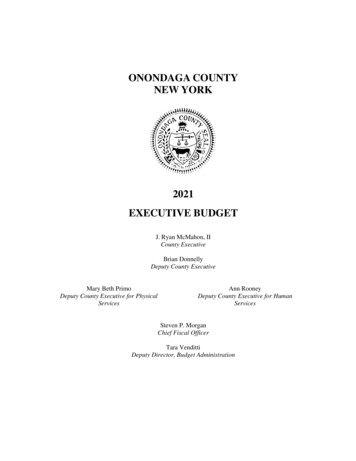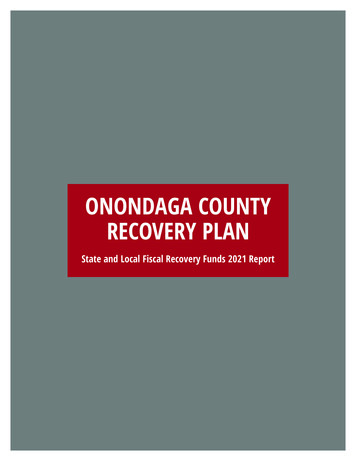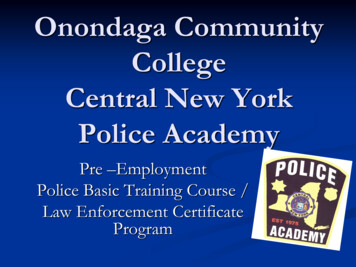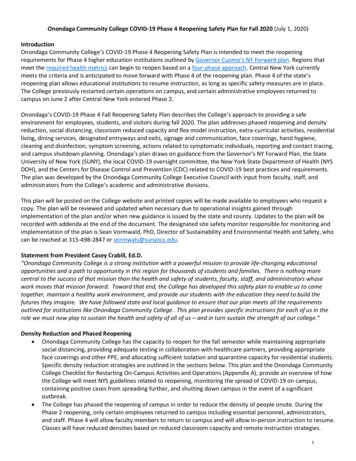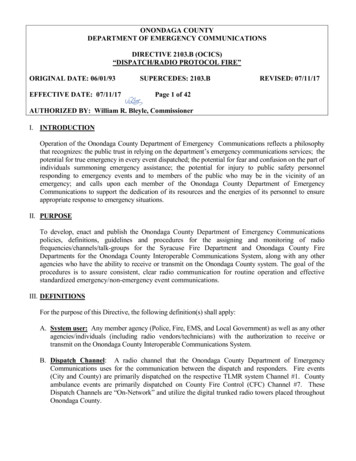
Transcription
ONONDAGA COUNTYDEPARTMENT OF EMERGENCY COMMUNICATIONSDIRECTIVE 2103.B (OCICS)“DISPATCH/RADIO PROTOCOL FIRE”ORIGINAL DATE: 06/01/93EFFECTIVE DATE: 07/11/17SUPERCEDES: 2103.BREVISED: 07/11/17Page 1 of 42AUTHORIZED BY: William R. Bleyle, CommissionerI. INTRODUCTIONOperation of the Onondaga County Department of Emergency Communications reflects a philosophythat recognizes: the public trust in relying on the department’s emergency communications services; thepotential for true emergency in every event dispatched; the potential for fear and confusion on the part ofindividuals summoning emergency assistance; the potential for injury to public safety personnelresponding to emergency events and to members of the public who may be in the vicinity of anemergency; and calls upon each member of the Onondaga County Department of EmergencyCommunications to support the dedication of its resources and the energies of its personnel to ensureappropriate response to emergency situations.II. PURPOSETo develop, enact and publish the Onondaga County Department of Emergency Communicationspolicies, definitions, guidelines and procedures for the assigning and monitoring of radiofrequencies/channels/talk-groups for the Syracuse Fire Department and Onondaga County FireDepartments for the Onondaga County Interoperable Communications System, along with any otheragencies who have the ability to receive or transmit on the Onondaga County system. The goal of theprocedures is to assure consistent, clear radio communication for routine operation and effectivestandardized emergency/non-emergency event communications.III. DEFINITIONSFor the purpose of this Directive, the following definition(s) shall apply:A. System user: Any member agency (Police, Fire, EMS, and Local Government) as well as any otheragencies/individuals (including radio vendors/technicians) with the authorization to receive ortransmit on the Onondaga County Interoperable Communications System.B. Dispatch Channel: A radio channel that the Onondaga County Department of EmergencyCommunications uses for the communication between the dispatch and responders. Fire events(City and County) are primarily dispatched on the respective TLMR system Channel #1. Countyambulance events are primarily dispatched on County Fire Control (CFC) Channel #7. TheseDispatch Channels are “On-Network” and utilize the digital trunked radio towers placed throughoutOnondaga County.
“DISPATCH/RADIO PROTOCOL FIRE ”CLASSIFICATION: 2103.BREVISED: 07/11/17Page 2 of 42C. Tactical Channel: A radio talk-group or channel that Fire or EMS agencies may use forcommunications during an emergency event. Most tactical channels are “on-network” and utilizethe digital trunked land mobile radio (TLMR) system towers placed throughout OnondagaCounty. These channels are recorded and may be monitored by the Onondaga CountyDepartment of Emergency Communications as personnel resources allow. The Department ofEmergency Communications also has the ability to transmit and simulcast on these as well. TheTactical Channels available for fire related emergency events are; Channels #2, 3, 4, 8, 9, 10, 11,12, 13, and 6 (some tactical channels have predetermined assignments such as TAC 12 which isused for any event on any lake (for Oneida Lake TAC 12 is automatically assigned) wheremultiple agencies from different counties are responding). Tactical channels will be assigned bythe Department of Emergency Communications as available on an “event driven” or an “asneeded and requested” basis.D. Command Channel: The primary channel for command is TLMR (City or County) Channel #5.This Command Channel is “on-network” and utilizes the digital trunked radio towers placedthroughout Onondaga County.E. Off-Network Channel: A radio channel that is low power (usually less that 5 watts) – simplexand doesn’t transmit through the digital TLMR system. The “off-network” channel on theprimary (CFC) radio zone is Channel #15. This channel is not able to be monitored by theOnondaga County Department of Emergency Communications. An “off-network” radio channelcommunication is generally a “line-of-sight distance transmission” dependent on objects thatcould impede that low power signal. Items such as trees, hills, and concrete/steel buildings arejust some examples of barriers that can limit the distance of all radio transmissions as well as an“off-network” radio transmission. Off-network channels can be used for on-scene tacticaloperations when the OCICS TLMR system is out of range.IMPORTANT NOTE: THE EMERGENCY TRAFFIC BUTTON WILL NOT FUNCTION ONOFF NETWORK CHANNELS.F. Inter-Op Channel: A radio channel that can be used for inter-agency communications betweenmultiple departments as well as multi-agencies. The primary Inter-Op channel betweenOnondaga County Fire and EMS units is referred to as FTAC and is an on-network radio channel.The primary Inter-Op channel for communications between multiple Onondaga County publicsafety disciplines (police/fire, EMS, local government, etc.) are the OTAC channels and is an onnetwork radio channel. Inter-Op channels for Central New York Communications Consortiumcounties that share the OCICS TLMR master site (i.e., Cayuga, Madison, Onondaga and Oswego)include, FWIDE (Fire), and EWIDE (EMS).G. Minor Events: A minor event can generally be defined as a request for service that a single unitor single fire department responds to. Some examples of minor events are; medical calls ofvarying nature, vehicle lockout, etc. and any other events where you wouldn’t necessarily need adedicated tactical channel to communicate with other units.
“DISPATCH/RADIO PROTOCOL FIRE ”CLASSIFICATION: 2103.BREVISED: 07/11/17Page 3 of 42H. Serious Events: A “Serious Event” will automatically be assigned a “tactical channel” by theOnondaga County Department of Emergency Communications. Some examples of serious eventsinclude multiple fire department or multiple station response to a reported or confirmed structurefire, aircraft emergencies, building collapses, boat/water emergencies, and hazardous materialsincidents. If the Incident Commander or unit operating at the event decides they do not require a“Tactical Channel”, he or she should advise the Department of Emergency Communications thatthey do not have a need for the assigned “tactical channel.”I. National Fire Protection Association (NFPA): Organization that establishes and updates fireprotection and prevention standards. NFPA publishes National Fire Codes, a 16-volume set ofstandards, manuals, and recommended practices, including those related to fire dispatch.IV. POLICYIt is the policy of the Onondaga County Department of Emergency Communications under theguidance of the Policy Review and Oversight Committee (PROC) to:A. Provide and maintain an updated protocol in order to ensure the safe, secure, and timely handling ofany call for service or radio transmissions.B. Provide the necessary reference/training materials to enable system users the ability to perform theirassigned job duties.C. Establish a standard procedure regarding dispatching of public safety field personnel.D. Ensure prompt dispatch of information to public safety field personnel by competent and welltrained staff in emergency and non-emergency situations.E. Develop and use assessment skills to identify prioritized events, browse waiting events, dispatchpublic safety personnel to waiting events as soon as possible, and make appropriate notifications tofield supervisors and 911 desk supervisors in a timely manner.F. Provide adequate initial and on-going training for public safety dispatchers to ensure the prompt andaccurate dispatch of information received.G. Ensure appropriate documentation of calls dispatched for service through the accurate and efficientuse of CAD and non-CAD (back-up) procedures.H. Provide additional and/or requested information to public safety field personnel and user agencies asnecessary and appropriate in accordance with the Department of Emergency Communicationsmission.I. Process fire calls (i.e., from the time received by the call-taker through dispatch) within theguidelines established by the National Fire Protection Association (NFPA) in Standard 1221. Ninetypercent of Fire calls in most cases should be processed within 64 seconds and Ninety five percentwithin 106 seconds.
“DISPATCH/RADIO PROTOCOL FIRE ”CLASSIFICATION: 2103.BREVISED: 07/11/17Page 4 of 42J. Act on the side of life safety in dispatching events. In any emergency situation where there isconflicting information as to the appropriate event type and there appears to be an imminent threat tolife or property, the dispatcher shall select and dispatch based on the most serious potential presentedand shall inform responding units of the conflicting information and updated information as it isreceived.K. Require employees to immediately report to a Shift Supervisor any fire event where:1. The processing time exceeded 64 seconds (Shift Supervisor);2. A processing delay of more than 106 seconds has occurred (Shift Supervisor); or3. The processing of the call may have a negative impact on the operation or credibility of theOnondaga County Department of Emergency Communications (Shift Supervisor).L. Comply with all federal, state and local laws rules regulations and standards, which may relate to thisDirective.V. GENERAL RADIO PROTOCOLSA. RADIO OPERATIONAL PROTOCOL/ROUTINE PROTOCOLS (ALL)1. All radio communications regardless of nature shall be restricted to the minimum practicaltransmission time and employ an efficient operating procedure. Transmissions of anexcessive length on a trunked radio system can have the unintended consequence of busyingthe system for other users. All OCICS radios are set to “time-out” after 30 seconds.2. Pronounce words distinctly.3. The voice should be as emotionless as possible; emotion tends to distort the voice and renderit unintelligible.4. Attempt to make your voice a regular monotone.5. Emergency messages require no expression, but a high degree of intelligibility.6. When utilizing the radio system, use common sense and courtesy. Listen before transmitting.7. The FCC forbids profanity (this is a violation of Federal Law Title 18) and any superfluousor extraneous transmissions.8. Information that would jeopardize emergency operations if known by non-emergency serviceproviders shall not be transmitted over the radio. The term “signal 32 medical” will not be usedover the radio or in any official communications from the Onondaga County Department ofEmergency Communications.
“DISPATCH/RADIO PROTOCOL FIRE ”CLASSIFICATION: 2103.BREVISED: 07/11/17Page 5 of 429. When a unit transmits (not on the user’s primary talk-group or channel) the name of the talkgroup or channel shall also be transmitted. For example, “North Syracuse Engine 6 onOTAC1.”10. Primary channels are used to dispatch calls for service, contact users assigned to that channeland coordinate day-to-day activities of each agency assigned to that channel. Specifictactical operations will be conducted on appropriate tactical talk-group/channel.11. Tactical talk-groups are used for tactical communications between field units and thedispatch center or between field units in accordance with established talk group protocols. Onlarger events, separate and unique tactical talk-groups may be assigned by the dispatch centerfor specific functions. Assignments for using agency specific talk-groups/channels are madeby the dispatch center. Assignments using county-wide talk-groups/channels are made bydispatch as requested by the Incident Commander or designee.12. Plain language shall be used for all radio communications. The use of codes, particularlyagency-specific codes, has been found to be a barrier in the transmission of information. Themost negative effect of codes is a reduction in communications interoperability during multiagency response.13. Phonetic Alphabet – A phonetic alphabet shall be used for spelling out unusual names, licenseplate letters and so forth. They are always transmitted as “Adam, “Boy,” or “Charles not “Aas in Adam,” etc. Due to the variations of phonetic alphabets, no one phonetic alphabet willbe required. Any phonetic alphabet the clearly identifies a letter is acceptable.14. Obtain clearance (from dispatch) prior to transmitting lengthy messages, such as descriptionsof suspects or notifications. Break every so often to allow any other unit that may have anurgent message to transmit.15. After you press the Push-to-Talk (PTT) switch, await the end of the “go ahead” tone beforespeaking. The conclusion of the “go ahead” tone means that you have the air at that instant andcan begin delivering your message. If another unit has the air, or the network is busy, you willreceive a “system busy” tone. If you receive a “system busy” tone, release the PTT switch andawait a “go ahead” tone, once receiving the “go ahead” tone, the user must press the PTT switchto transmit.The system will automatically give you the air once the air is available for your transmission.Do not continue to press the PTT button after receiving a “system busy” tone. Doing so willcause you to lose your place in the queue and will be put to the end of the queue list.16. Think before your speak – DON'T press the Push-to-Talk button until you know what you wantto say in your transmission.17. Make all transmissions brief and concise. If you must transmit a lot of information, break itinto several shorter transmissions, the radio system will automatically end transmissions thatare over thirty seconds.
“DISPATCH/RADIO PROTOCOL FIRE ”CLASSIFICATION: 2103.BREVISED: 07/11/17Page 6 of 4218. Don't use unnecessary words, such as "please" and "thank you". These words waste air time.19. Do not use words or inflections that reflect humor, irritation, sarcasm, or disgust. Alltransmissions should be impersonal and professional. Additionally, do not make “catcalls” orplay music and/or sound effects over the radio.This activity violates FederalCommunications Commission (FCC) rules and regulations. Furthermore, personnel mustrefrain from creating background noises that may be disruptive or sound un-professional tothose agencies on or monitoring the OCICS. (e.g. laughing, loud talking) Fire and EMSdispatchers (this includes personnel who are assigned as TA’s) shall wear their headsets at alltimes while operating the radio so as to limit the amount of background noise and presentconsistent audio levels for field units.20. Make only necessary transmissions–you are sharing a limited number of radio channels withall other radio users INCLUDING PUBLIC SAFETY AGENCIES. You do not know whenemergency communications are in progress on other talk groups and your unnecessarytransmission may delay another radio user reporting or responding to an emergency event.21. Don't ignore a call to your radio. If you cannot deal with the transmission immediately, askthe caller to standby and re-contact them as soon as you are able. If you have not heard all of atransmission to you, never guess at the missing information. Ask the other person to repeat orclarify the message before acknowledging you understand it.B. GUIDELINES: GENERAL/ASSUMING DISPATCH DUTIES:1. RELAY OF INFORMATION: At the time of dispatch relief or shift change, the dispatchergoing off-duty or being relieved shall convey information regarding pending calls, major eventsand ongoing events, or temporary changes in procedures, to the dispatcher going on duty toensure continuity of coverage. This includes ensuring the appropriate personnel and equipmentresources are in place before dispatch duties are transferred. The oncoming dispatcher shallimmediately review the status of all pending and dispatched events as well as any notesregarding temporary changes in procedure.2. COMPUTER ENTRY: When assigned to the fire pod, all personnel shall immediately log ontothe CAD terminal when relieving the previous dispatcher (dispatch terminals should never be leftlogged off). Someone should always be logged on. Dispatchers assigned to the SFD TA, CFCTA and spare fire positions will log onto Vesta and CAD.NOTE: Logging onto the CAD system supersedes the previous dispatcher's log-on,thereby updating the system.
“DISPATCH/RADIO PROTOCOL FIRE ”CLASSIFICATION: 2103.BREVISED: 07/11/17Page 7 of 42C. GUIDELINES: GENERAL/DISPATCH DUTIES:1. COPY COMMAND ACKNOWLEDGMENT: When a dispatcher sends a CAD event via theCopy Command, he/she will verify that the event was received by the appropriate dispatcher. Ifan acknowledgment is not received, the sending dispatcher will immediately activate their bluelight and advise their supervisor. All events that are copied to EMS must also be copied to theappropriate fire dispatcher. For example: when a police unit arrives at the scene of a previouslyreported MVCDB and determines that an ambulance is needed, the event must be copied to bothEMS and the appropriate fire dispatcher.2. PROMPT ACKNOWLEDGEMENT OF FIELD PERSONNEL: All incoming radiotransmissions to the dispatcher shall be answered promptly, in a professional manner andacknowledged with the time. Dispatchers not ready to accept radio transmissions shall indicatethis by using the term “stand by.” Telephone conversation of a non-emergency nature shall nottake precedence over radio transmissions.3. ACCURACY: All pertinent Information provided by call-takers is to be accurately relayed tofield personnel. Any additional information relayed to the dispatcher shall be promptlytransmitted to field personnel as well as added to the event notes. Information provided by fieldpersonnel for notifications shall be relayed exactly. Dispatchers must listen carefully to alltransmissions and obtain specific information. Dispatchers shall accurately record informationregarding field unit locations(s) and event(s). NEVER ASSUME! Be sure to record allinformation accurately.4. ACTIVITIES AT THE ONONDAGA COUNTY DEPARTMENT OF EMERGENCYCOMMUNICATIONS: Dispatchers should always be aware of other ongoing events related totheir assigned dispatch area as well as activities on other radio channels. Dispatchers shallobserve their terminal monitor(s) for unit status and status checking, as well as “WaitingEvents.”5. PROFESSIONAL MANNER:All radio transmissions within the Onondaga CountyDepartment of Emergency Communications systems shall be conducted in a calm, courteous,businesslike manner. Unnecessary chatter is unacceptable, as it uses air time unnecessarily andmay adversely affect responder safety, in addition to violating FCC rules and regulations.6. RESPECTFUL REFERENCE: Field units shall be referred to by their appropriate unit number.It is acceptable to use the term “Chief” when acknowledging transmissions from Chief Officers.7. TONE OF VOICE: All personnel shall speak clearly and at a constant rate while transmitting.The practice of varying the voice frequency/level will also be monitored by the dispatcher.Raising and lowering the voice, changing the pitch, causes excessive level changes, thus nonuniform transmissions. Such inflections may also cause confusion or concern to other stationsor units monitoring.
“DISPATCH/RADIO PROTOCOL FIRE ”CLASSIFICATION: 2103.BREVISED: 07/11/17Page 8 of 428. CLEAR DICTION: All personnel shall enunciate in a clear, resonant voice, speak at a constantrate and unhurried manner, assuring that each spoken word is apart from all others. The use offoreign objects in the mouth such as (tobacco, gum, candy, and food) is strictly prohibited. Thesesubstances can affect clarity of diction, and diminish effectiveness in communicating.9. DEMEANOR: Personnel engaged in telephone or radio communications shall not becomeargumentative, curt, sarcastic or rude.10. PROPER LANGUAGE: Proper language shall be used at all times. Profanity and slangterminology shall not be used. (See Directive 2101, RADIO COMMUNICATIONS:MESSAGE/SIGNAL FORMAT.)11. SIGNAL 32 MEDICAL: The term Signal 32 Medical is not to be used over the radio or in anyofficial communication from the Department of Emergency Communications as this practice isconsidered unlawful.12. RELEASE OF INFORMATION/HIPPA RESTRICTIONS: Per our County Health DepartmentHIPPA officer, the Department of Emergency Communications is not a covered entity underH.I.P.P.A. As a result we may release any information that is normally acceptable for releaseunder our policies and County Law. This would include confirming that we dispatched anambulance or a fire department to a specific location. We can even release information that theambulance then went in route to a specific hospital if that information went out over the radio.13. USE OF EQUIPMENT: Audio transmission levels shall be maintained at all positions. Whenassigned to a position requiring a headset-type microphone, the device will be used only asdesigned. The practice of placing the headset on work surfaces or hand holding the samewhile transmitting is prohibited (The attached gooseneck microphone shall be used only as abackup for all positions including the TA’s.)Dispatchers are not to leave their assigned workstation area. Wireless Headsets are set-upfor the immediate area of your assigned workstation. If the remote unit loses connection with itsbase unit, then Wireless headsets can experience up to 45 - 60 seconds of “disconnect” or loss offunctionality and it is possible that an open microphone can occur.Note: If you hear a triple “beep”, the remote is too far from the base unit. Rule of Thumb. Ifyou cannot read your CAD Screen/Banner, you are too far away and may not to be able toreceive a Signal 49/50, Traffic/Suspect Pursuit, Rolling Data, critical CAD update, etc.Dispatchers are not to walk to Supervisors’ Desk, DATA, CT positions, Printer/Copier, etc.14. MAINTAINING BROADCAST LEVELS: All headsets that are used at the control center arenoise-cancelling. They are designed to reduce background and other unwanted noise.Because of their design, this distance between the mouth and the headset mouth piecemicrophones will generally be a one-finger distance. The distance will vary depending onvoice resonances and must be considered by each dispatcher. The two determining factorsthat will be considered as measurement are:
“DISPATCH/RADIO PROTOCOL FIRE ”CLASSIFICATION: 2103.BREVISED: 07/11/17Page 9 of 42a. Mouthpiece adjusted so as to prevent background and wind noise from entering thesystem.b. That the VU (volume unit) meter reading is showing a green bar. If a red bar is displayingthe audio is not at an acceptable level.15. RADIO TRANSMITTER TEST COUNTS. Whenever necessary for the purpose of testingequipment or audio levels, test counts may be requested. These tests may be requested by thecontrol center, field units or repair technicians (radio vendors).These types of test counts that may be used are generally referred to as “5 count” or “shortcount” and/or “10/count”. If requested or given, the following will determine the method:a. When giving either a 5 or 10 count, start with 1 and count to 5 or 10. Repeat the lastnumber (5 or 10) and count down to 1. The duration between each number will be 1second.16. CONFIRMATION OF SIGNAL – Dispatchers should observe the radio console monitor andconfirm outgoing audio transmissions by visually verifying the VU meter signal. Also whenthere is an incoming or outgoing signal (on a selected channel) the orange light on the lightpole at the dispatch position will light up signifying reception of incoming audio. If there isno indication a dispatcher transmitting voice or tones, and the dispatcher does not observe anyindicators of an outgoing transmission, the dispatcher must discontinue the transmission andre-broadcast.17. PRIMARY DISPATCH POSITIONS – Fire pod staffing will be five fire dispatchers assignedto the fire pod for all shifts. Fifteen minute breaks and lunches will be covered with a reliefperson. For quick bathroom breaks when activity is low a relief person will not be required.a. For quick breaks when a relief person is not required, if the County fire or EMSDispatcher should leave the pod area, the County Fire TA shall monitor the appropriateCAD folders and radio channels. Upon return both dispatchers assume responsibility fortheir normal dispatch duties.b. The primary Syracuse Fire Dispatch position will be filled at all times, for quick breakswhen a relief person is not required, should the primary Syracuse Fire Dispatcher leavethe fire pod area, the Syracuse Fire TA shall monitor the appropriate CAD folders andradio channels. Upon return the primary Syracuse Fire Dispatcher will assumeresponsibility for their normal dispatch duties.At the time of dispatch shift change as mentioned in A, B above (including coverage forbreaks), the dispatcher going off-duty shall convey information regarding major eventsand on-going events, or temporary changes in procedures, to the dispatcher going on dutyto ensure continuity of coverage. This includes ensuring the appropriate personnel andequipment resources are in place before dispatch duties are transferred.
“DISPATCH/RADIO PROTOCOL FIRE ”CLASSIFICATION: 2103.BREVISED: 07/11/17Page 10 of 4218. MONITORING OF ALL FIRE AND EMS EVENTS – Individuals sitting at the TA positionsfor both County and City shall monitor all CAD fire control folders. They will assist eachother in monitoring incoming CAD events. At all times, each member should work as a teamand shall exercise additional vigilance in monitoring activity in the fire pod.19. ELAPSED TIME – Will be instituted upon dispatch of a reported structure fire or HAZMATevent.a. At each ten (10) minute interval, the dispatcher will contact Incident Command and advisethem how much time has elapsed (EX: “Fire Control to Solvay Command, elapsed time is10 minutes”. – “Fire Control to Solvay Command, elapsed time is 20 minutes”).Syracuse Fire – the announcement shall be made only on the fireground channel they areusing.County Fire – the announcement shall be made on Channel 5. If you do not receive anacknowledgement from the Incident Commander (County only), you should attempt to reachthem (or any unit on scene) on the primary dispatch channelb. This process will remain in effect until the Incident Commander advises that no furtherupdates are needed. Any information or size up relayed to you by Incident Command duringthese notifications should be entered into CAD.20. SHARING OF INFORMATION: Fire dispatchers are responsible to supplement all police callsif advised that police are not needed or in the case of significant status changes like the firedepartment has cleared the call.21. CAD/PAGE NOTIFICATIONS: Whenever a page is sent regarding a Fire notification suchas the EM signal 99 group, the hazardous materials group etc. the employee initiating the pageis to notify the desk that the page has been sent. The supervisor working the desk can thenmonitor the pager to determine when or if the page actually went out.D. GUIDELINES: GENERAL/DISPATCH DUTIES/ROUTINE TRAFFIC1. All radio communication should be brief and to the point. Radio system traffic shall belimited to official business only. Agency heads are responsible for the appropriate use of thesystem in accordance with adopted standard protocols. Proper radio etiquette is expected onany communications system. Agency protocols will dictate operations locally.2. Radio messages will be made and received in the following manner:a. Caller waits for go-ahead tone on selected talk-group.b. When initiating communication off the unit’s normally assigned talk group the followingformat will be used. “Unit on talk-group used”. “Taunton Car 1 on FTAC 1”.
“DISPATCH/RADIO PROTOCOL FIRE ”CLASSIFICATION: 2103.BREVISED: 07/11/17Page 11 of 423. Receiver acknowledges by stating their county assigned/approved call sign.4. When utilizing private agency talk-groups, call sign protocol is at agency discretion.5. Local Operation: Normal operations will be conducted on assigned agency talk-groups.6. Operation outside of local area. County of Onondaga:(Fire department, mutual aid and ambulances, EMT vehicles for a period of time may requirethat current radio equipment continue to be installed.)a. Members traveling outside their normal operating area (Onondaga County) will switchfrom their OCICS UHF radio to the appropriate adjoining county frequency if their radiois programmed or may ask the dispatcher to do a patch with a national interoperablechannel if applicable.b. As counties and cities throughout the state adopt interoperable capability under theNational Public Safety Telecommunications Council (NPSTC) Nationwide InteroperableChannel Plan; all OCICS UHF radios will then have access to those areas so equipped.All surrounding counties are in the process of adopting and constructing such systems.Onondaga is now so equipped.NPSTC bands include VTAC, UTAC and 8TAC bands. Once equipped all OCICS publicsafety radios will be capable of interoperable communications on UTAC channels. Thereare four UTAC channels, a “CALL” channel and three operating channels. The callingfield unit may be directed to one of the operational (UTAC) channels.E. GUIDELINES: GENERAL/DISPATCH DUTIES/EVENTSAn event is defined as a non-scheduled significant event that requires the coordinated responseand interoperability of multiple agencies or jurisdictions, this includes events that move betweenjurisdictions.1. When a situation dictates coordinated resources from agencies without common talk-groups,communications will be on interoperable talk-groups. (Ex., County Wide Interoperable 1(display name OTAC ALL).2. The responsible radio dispatcher will be notified by the requesting agency or EventCommander when the requested talk-group(s) will no longer be needed.
“DISPATCH/RADIO PROTOCOL FIRE ”CLASSIFICATION: 2103.BREVISED: 07/11/17Page 12 of 42F. GUIDELINES: GENERAL/DISPATCH DUTIES/SPECIAL EVENTS PLANNED/SCHEDULED1. Definition of a special event - Any event, known
Onondaga County Fire and EMS units is referred to as FTAC and is an on-network radio channel. . field supervisors and 911 desk supervisors in a timely manner. . use of CAD and non-CAD (back-up) procedures.
